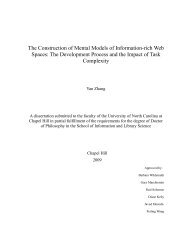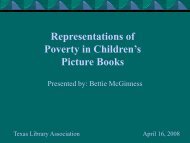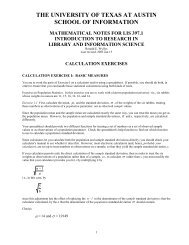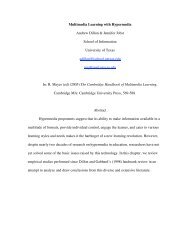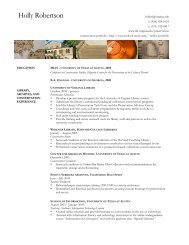North American Graduate Programs in the Conservation of
North American Graduate Programs in the Conservation of
North American Graduate Programs in the Conservation of
Create successful ePaper yourself
Turn your PDF publications into a flip-book with our unique Google optimized e-Paper software.
The Fogg's formal apprenticeship program began <strong>in</strong> 1972 and <strong>in</strong> <strong>the</strong><br />
eight years <strong>of</strong> its existence awarded certificates to eleven graduates.<br />
Elizabeth Jones, Marjorie Cohn, and Arthur Beale were responsible for<br />
formaliz<strong>in</strong>g <strong>the</strong> apprenticeships. In a memo dated December 10, 1971, to<br />
Daniel Robb<strong>in</strong>s, <strong>the</strong>n director <strong>of</strong> <strong>the</strong> Fogg, Miss Jones <strong>in</strong>itially argued<br />
aga<strong>in</strong>st undertak<strong>in</strong>g a large-scale conservation tra<strong>in</strong><strong>in</strong>g program for several<br />
reasons. First, she was concerned about job placement, not<strong>in</strong>g that<br />
"unless <strong>the</strong> economy takes an enormous leap forward, <strong>the</strong>re will be severe<br />
competition for jobs. . .." Second, she felt it was <strong>in</strong>appropriate to undertake<br />
an extensive program <strong>of</strong> pr<strong>of</strong>essional tra<strong>in</strong><strong>in</strong>g until a "research laboratory"<br />
was <strong>in</strong> work<strong>in</strong>g order. Sav<strong>in</strong>g her strongest argument for last, she<br />
proposed <strong>the</strong> follow<strong>in</strong>g:<br />
. . . We can make our greatest contribution <strong>in</strong> <strong>the</strong> unique function<br />
we have here teach<strong>in</strong>g our own students <strong>of</strong> F<strong>in</strong>e Arts about<br />
<strong>the</strong> history <strong>of</strong> materials and techniques and about conservation,<br />
and <strong>in</strong> cont<strong>in</strong>u<strong>in</strong>g our collaboration with <strong>the</strong> curators, faculty,<br />
and students <strong>in</strong> <strong>in</strong>vestigat<strong>in</strong>g problems <strong>in</strong> art history and <strong>in</strong><br />
archaeology. We should like to extend <strong>the</strong>se aspects <strong>of</strong> our work<br />
<strong>in</strong> a more substantial and organized format.<br />
The first prerequisite for <strong>the</strong> preservation <strong>of</strong> a work <strong>of</strong> art is an<br />
<strong>in</strong>telligent understand<strong>in</strong>g <strong>of</strong> <strong>the</strong> physical nature <strong>of</strong> its materials<br />
and handl<strong>in</strong>g dur<strong>in</strong>g its previous existence. The time, energy, and<br />
money spent <strong>in</strong> tra<strong>in</strong><strong>in</strong>g your pr<strong>of</strong>essionals <strong>in</strong> conservation will<br />
be wasted if <strong>the</strong> next generation <strong>of</strong> museum men, archaeologists<br />
and art historians, trustees and collectors (who will be hir<strong>in</strong>g <strong>the</strong><br />
pr<strong>of</strong>essionals) are left <strong>in</strong> a state <strong>of</strong> ignorance.<br />
In <strong>the</strong> end, a small formal program was <strong>in</strong>itiated, and <strong>in</strong> February <strong>of</strong><br />
1972 two proposals went to <strong>the</strong> NEA to "expand and regularize our contribution<br />
to <strong>the</strong> tra<strong>in</strong><strong>in</strong>g <strong>of</strong> pr<strong>of</strong>essional "conservators" and "to <strong>in</strong>crease a<br />
research facility." By <strong>the</strong> fall <strong>of</strong> 1972, a basic curriculum for <strong>the</strong> apprenticeship<br />
program had been developed and was be<strong>in</strong>g put <strong>in</strong>to practice.<br />
Throughout <strong>the</strong> year, much was discussed and written about <strong>the</strong> role <strong>of</strong><br />
science <strong>in</strong> <strong>the</strong> Fogg's tra<strong>in</strong><strong>in</strong>g efforts, which was simply stated <strong>in</strong> an early<br />
document: "Our expanded program <strong>of</strong> tra<strong>in</strong><strong>in</strong>g new conservators br<strong>in</strong>gs<br />
an obligation to provide a solid ground <strong>in</strong> <strong>the</strong> aspects <strong>of</strong> modern science<br />
which relate to <strong>the</strong> problems <strong>of</strong> <strong>the</strong> conservation <strong>of</strong> works <strong>of</strong> art."<br />
Although <strong>the</strong> Fogg did receive NEA support that year for <strong>the</strong> conservation<br />
tra<strong>in</strong><strong>in</strong>g program, it was not <strong>in</strong>itially successful with <strong>the</strong> funds for <strong>the</strong><br />
26



